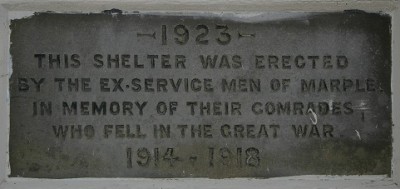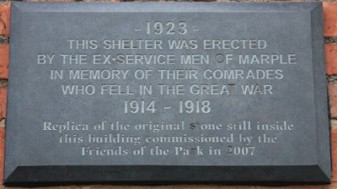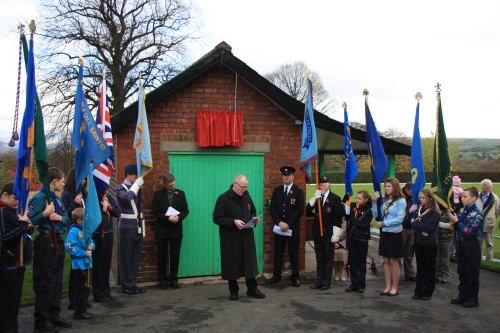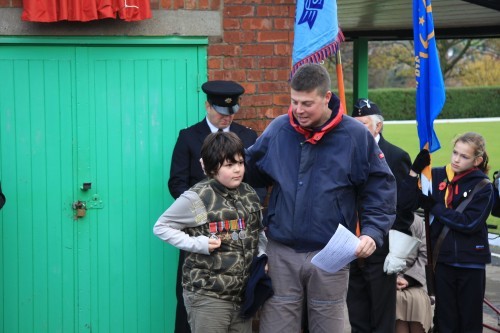|
The Marple Website - Fighting To Keep Our Heritage Safe |
Erection of Replica Memorial Stone
Through our association with the Friends of Marple Memorial Park we recently became aware that there is a memorial stone inside what is now the council’s tool shed and office near to the Bowling Green in Memorial Park. The stone explains that the building was erected in 1923 by the ex-servicemen of Marple who returned from the First World War in memory of their comrades who did not, which means that the building is actually a war memorial.
 The original stone inside the building |
 The new replica stone |
We think that when it was originally built as a 'shelter’ it was open fronted, allowing spectators to watch the bowling in comfort, and the stone was easily visible. Since the building became fully enclosed the stone has disappeared from view and faded from memory.
We felt that this fact should not be forgotten and made a donation of £500 from the profits of our 2007 Marple and Mellor calendar to the Friends of the Park, who were then able to commission a replica of the original stone to go on the outside of the building for all to see and to understand why it was built.
With the help of Tony Donovan from Stockport NPS, the stone was erected free of charge on the gable end of the building in good time to tie an unveiling ceremony in with the Remembrance Day Service on Sunday 11th November 2007.

Peter introduces the proceedings
The ceremony was organised by our own Peter Clarke, who is also the local War Memorials Trust representative. Peter introduced the proceedings at the shelter immediately after the normal service and the new stone was unveiled by local lady Enid Wheeldon, whose uncle Sidney Proctor was one of the 141 Marple soldiers killed during the First World War. Andy Cook, co-author of Remembered, the book about the soldiers commemorated on Marple's War Memorial, spoke about the importance of the building as a memorial and why its origins should not be forgotten. The Reverend Chris Ambler, who conducted the Remembrance Day Service said a prayer of thanks and blessed the new memorial in front of a large audience.

Andy Cook and son Adam tell why the shelter
built by ex-servicemen is so special.
|
|
|
Thanks are due to many, but especially to Andy Cook for sharing his personal view of what the shelter meant to the ex-servicemen who built it, Tony Donovan of Stockport NPS for arranging the erection at no charge, Gill Whittaker for making the curtain used in the ceremony and Stockport's Parks & Recreation staff for their help and cooperation.
Below are Andy Cook's notes for the talk he gave during the unveiling ceremony:
|
THE FELLOWSHIP OF THE PAVILION Why a small bowling pavilion, just a simple shelter in a park? I ask myself. With a War Memorial in clear view. NO EGOTISM!! This is for the ex-soldiers - the memorial is for all. The war was waged by Battalions, not by individuals; by bands of men who, if the spirit were right, lived in such intimacy that they became part of one another. An unforgettable experience for those who ever shared in it. A simple, communal pavilion where in a normal atmosphere that fellowship and understanding which 'grew up' amongst front line soldiers could be felt again by those men. Terrible ordeals and grievous suffering would not be the order of the day but merely forgotten details of Battalion life in wartime. Forgotten impressions made on them at the time, and they would have nodded and laughed and wondered "how could I have forgotten it?" The homely smell of breakfast. Bacon, served to preserve sanity and humanity at the battlefront. The arrival of the ration party 'the event of the day', this brought touch with the outside world. To enjoy ease it is surely necessary to
labour. To enjoy luxury it is necessary to live
hard. The battle areas were very crowded places, the daytimes were dead but at nightime they came alive. In contrast to civilian life the atmosphere of the dark was pervaded with friendliness as it provided a natural cloak and also precluded loneliness. To be alone was the rarest of wartime experiences, so rare indeed that when it happened it produced an acute sense of unease. Did this also run into post war life and did the shelter help keep the loneliness at bay. Through being together, more truly together than they would ever be again, the men in at the front found the power to endure the war. Terrifying and uncomfortable as their war was some said it was the happiest times of their lives where they saw the worst let loose, but also saw the finest qualities in men. In spite of rank, they were comrades and brothers sharing that experience. They saw in each other the inner self that in peacetime is all too often subdued for lack of opportunity of expression. Of the fellowship of the soldier it was said that: "Despite all the Christian Fellowship and international peace there is more animosity, uncharitableness and lack of fellowship in one business office now than in a Brigade of infantry in France during 1914 - 18" - otherwise we could not have stuck it!". How appealing this building must have seemed to those men of the fellowship of 14-18. They developed sympathy and understanding instead of wealth and built solid foundations of a philosophy of life which lasted not long enough. They felt that they had gained wisdom, a hard fought wisdom, and it was in this pavilion that those men, made wiser by the war, gathered. They dedicated it, not to themselves, but to those who did not make it back to Marple to share in that. Fellowship Of The Pavilion
|